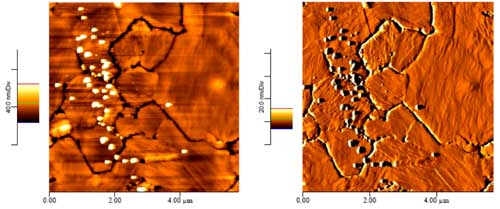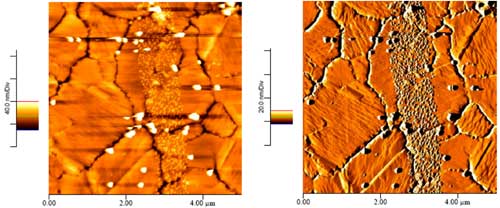| Posted: Aug 06, 2007 | |
The long road to molecular electronics could be paved with DNA |
|
| (Nanowerk Spotlight) One of the many fascinating concepts in nanotechnology is the vision of molecular electronics. If realized, the shift in size from even the smallest computer chip today would be staggering - a quantum leap, so to speak (literally). Look at it this way: a single drop of water contains more molecules (approx. 1.67 x 1023) than the billions and billions of silicon chips ever produced. | |
| Molecular electronics engineers of tomorrow might use individual molecules to perform the functions in an electronic circuit that are performed by semiconductor devices today. Don't get your hopes up, though, that your next iPod will be truly nano. Scientists today are still struggling with the most basic requirements for molecular electronics, for instance, how to precisely and reliably position individual molecules on a surface. | |
DNA-based molecular electronics |
|
| DNA-based nanostructuring is one approach that could lead to promising results. It has already been shown that DNA could be used to structure nanoscale surfaces. Now, a team in Germany has demonstrated that nanoscale objects of very different size can be deposited simultaneously and site-selectively onto DNA-displaying surfaces, based on sequence-specific DNA-DNA duplex formation. | |
| Already widely used today, DNA microarrays (also called DNA chips) that can contain hundreds of thousands of distinct probes, each bearing a reagent whose molecular recognition of a complementary molecule can lead to a signal that is detected by an imaging technology, most often fluorescence. The traditional solid-phase array is a collection of DNA molecules attached to a solid surface, such as glass, plastic or silicon chip. | |
| The ability of DNA sequences to bind to surfaces site-selectively has intrigued scientists who are excited by the vision of molecular electronics and who struggle with finding robust techniques that would allow the structuring of surfaces with nanometer precision. | |
| "We know that DNA-based structuring can be done in principle" Prof. Clemens Richert tells Nanowerk. "We now have developed a biomolecule-driven nanostructuring process that can be achieved with sub-micrometer spatial resolution, using dip-pen nanolithography. Our methodology, in combination with nanolithography or similar techniques, might lead to a robust way of generating nanostructured surfaces, including surfaces for molecular electronics." | |
| Richert's research group at the University of Karlsruhe worked with colleagues from the university's Institute of Physical Chemistry and the Forschungszentrum Karlsruhe (both now part of the Karlsruhe Institute of Technology - KIT) to develop a technique that resulted in DNA-based self-sorting of nanoparticles. They applied lanes of DNA to different regions of a gold surface, and each lane then attracted a different population of nanoparticles ("DNA-Based Self-Sorting of Nanoparticles on Gold Surfaces"). | |

|
|

|
AFM images of gold nanoparticles adsorbed onto DNA-displaying gold surfaces (Images acquired by Ulrich Plutowski) |
| "We are not aware of a study in which nanoparticles of so different a diameter (meaning that they offer very different surface areas with which they can bind to the surface) have been deposited site selectively, based on DNA-DNA interactions" says Richert, "and it was unheard of that it could be done with this level of reproducibility and accuracy." | |
| Since it is known that DNA can be covalently linked to them, the researchers in Karlsruhe chose gold nanoparticles of 15?60 nm diameter and planar gold surfaces for their study. Richert says that gold nanoparticles, particularly nanoparticles of a larger diameter, readily adsorb onto gold surfaces. "The interactions competing with sequence-specific DNA?DNA duplex formation can be quite strong." | |
| Also, there is more than an order of magnitude difference in aggregate binding strength between the 15 nm and 60 nm nanoparticles. A 15 nm particle carries approximately 125 DNA strands whereas the 60 nm particle carries approximately 2,000 strands. | |
| In order to negate the strong competing interactions, the researchers experimented with 'filler molecules' for the nanoparticle surface. "Beyond its simple steric function, our filler should serve two important roles" says Richert: "1) preventing binding of the DNA to the gold surface, and 2) suppressing base pairing between short stretches of otherwise noncomplementary DNA." | |
| After a bit of trial and error, the team finally came up with an optimized protocol that performed well in control experiments, including hybridization with one type of nanoparticles only, the use of partially complementary third strands, and addition of fully unrelated, noncovalently linked DNA. | |
Self-assembly for molecular electronics |
|
| The Richert Group's long-term goal is to assemble circuits on the level of molecular electronics. They have programs involving single-walled carbon nanotubes ("An Unexpected New Optimum in the Structure Space of DNA Solubilizing Single-Walled Carbon Nanotubes") and gold nanoparticles (e.g. their most recent work cited above). In addition, they are studying the deposition of DNA-coated carbon nanotubes. | |
| Assembly processes on the nanoscale that are based on interactions between biomacromolecules are notoriously tricky. A key issue is how to make them reliable and high-yielding. | |
| "We believe one of the key problems on the nanoscale is that the multivalent character of the molecular interactions also strengthens undesirable forces that are weak on the level of small molecules, such as unspecific adsorption, or formation of small partially matched duplexes between DNA strands" says Richert. "Taming these on the nanoscale is as difficult as inducing the desired interactions themselves. One of our long-term goals is to achieve the level of multiplexing that can currently be achieved with DNA microarrays using DNA-bearing nanoparticles." | |
 By
Michael
Berger
– Michael is author of three books by the Royal Society of Chemistry:
Nano-Society: Pushing the Boundaries of Technology,
Nanotechnology: The Future is Tiny, and
Nanoengineering: The Skills and Tools Making Technology Invisible
Copyright ©
Nanowerk LLC
By
Michael
Berger
– Michael is author of three books by the Royal Society of Chemistry:
Nano-Society: Pushing the Boundaries of Technology,
Nanotechnology: The Future is Tiny, and
Nanoengineering: The Skills and Tools Making Technology Invisible
Copyright ©
Nanowerk LLC
|
Become a Spotlight guest author! Join our large and growing group of guest contributors. Have you just published a scientific paper or have other exciting developments to share with the nanotechnology community? Here is how to publish on nanowerk.com.
